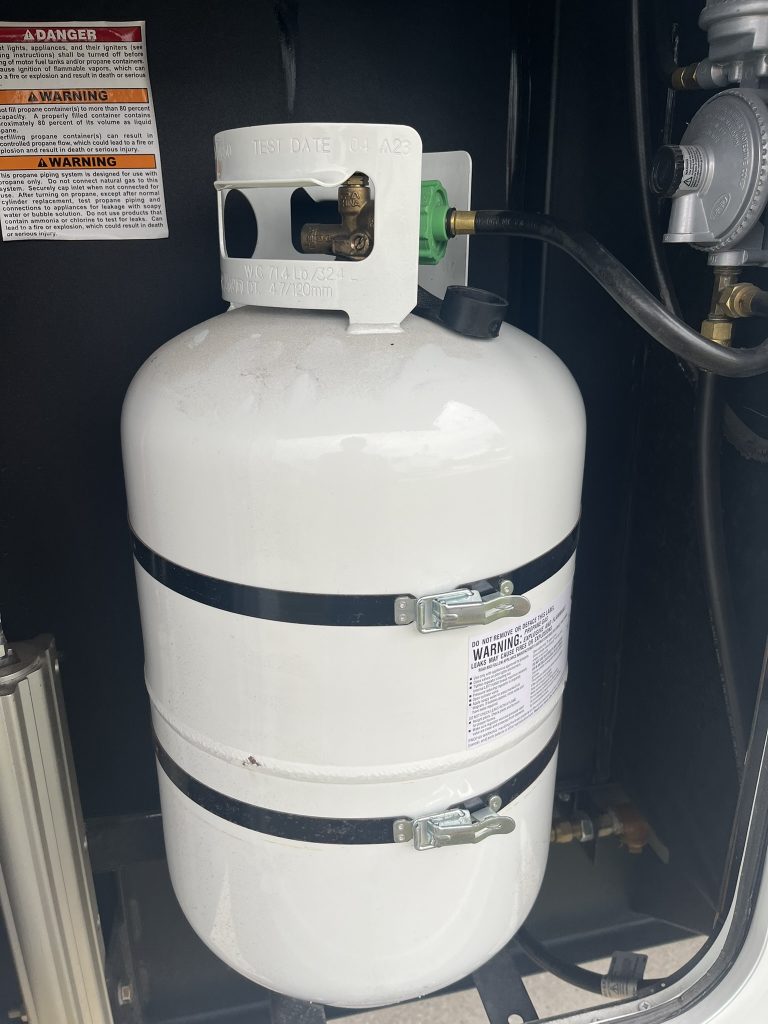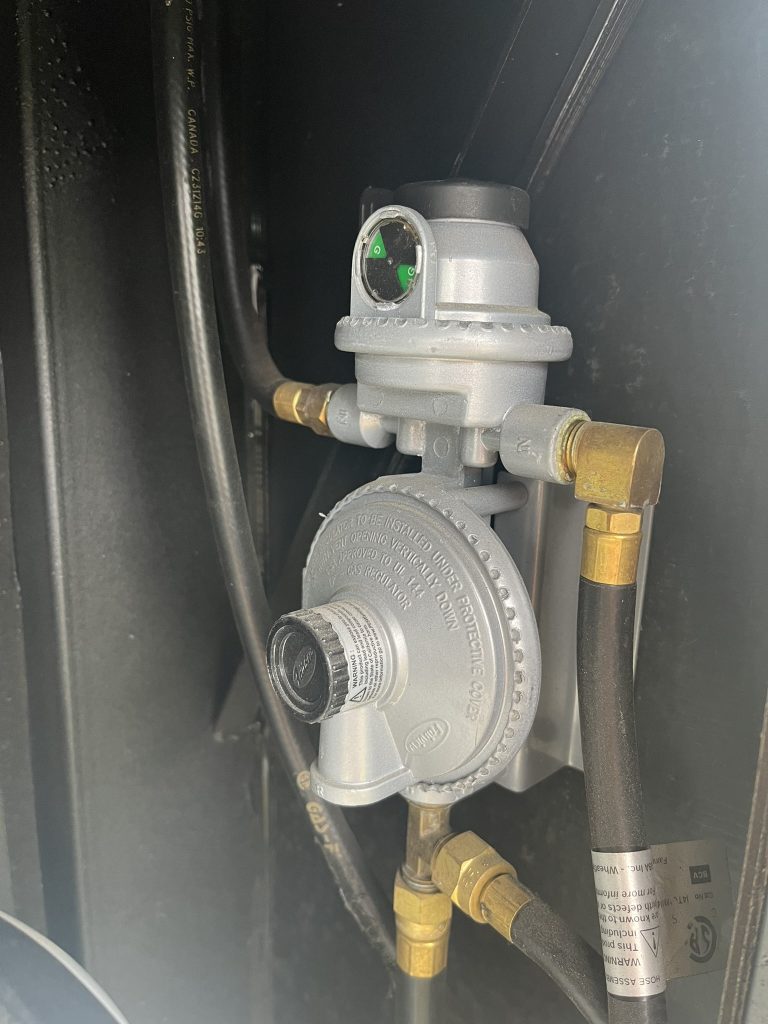
Nothing sends chills down an RV owner’s spine quite like propane system issues on the road. Whether it’s a malfunctioning water heater, a furnace on a chilly morning or a stove that won’t light during dinner prep, propane problems can quickly turn your dream adventure into a camping nightmare.
Your RV’s propane system is the lifeline of comfort in your home-on-wheels, powering everything from cooking to heating. Yet, many RV owners unknowingly neglect this crucial system until something goes wrong. The good news? With proper maintenance and care, you can prevent most propane-related headaches and ensure your system runs safely and efficiently for years to come.
In this comprehensive guide, we’ll walk you through everything you need to know about maintaining your RV’s propane system, from basic inspection routines to advanced troubleshooting techniques. Let’s dive into the essentials of keeping your propane system in peak condition, ensuring your adventures stay memorable for all the right reasons.
Understanding Your RV Propane System
Basic Components and Their Functions
The RV propane system consists of several crucial components working together to deliver safe and efficient fuel distribution:
| Component | Primary Function |
| Propane Tank | Stores liquid propane under pressure |
| Regulator | Controls pressure and flow of gas |
| Supply Lines | Transports gas to appliances |
| Auto-Changeover | Switches between tanks automatically |
| Shut-off Valves | Controls gas flow to individual appliances |
Safety Features and Mechanisms
Essential safety features in modern RV propane systems include:
- Automatic shut-off valves that activate during leaks
- Pressure relief valves to prevent tank overpressure
- LP gas detectors for leak identification
- OPD (Overfill Protection Device) valves
- Color-coded tank indicators for fill levels
Common Pressure Ratings and Measurements
Standard pressure measurements for RV propane systems:
- Tank pressure: 100-200 PSI
- First stage regulation: 10-15 PSI
- Second stage regulation: 11 inches water column (approximately 0.4 PSI)
- Standard tank sizes: 20, 30, and 40 pounds
Regular monitoring of these pressure ratings ensures optimal system performance and safety. With proper understanding of these basic components and measurements, let’s explore the essential inspection protocols that keep your RV propane system running safely.
Regular Inspection Protocols
Weekly Visual Checks
- Check for physical damage to tanks and lines
- Inspect regulator for rust or corrosion
- Verify gauge readings and tank levels
- Look for signs of leaks around fittings
- Ensure tank mounting brackets are secure
Monthly Connection Tests
- Test all connections using soapy water solution
- Verify proper operation of shut-off valves
- Check rubber hoses for cracks or wear
- Inspect pigtail connections
- Test detector functionality
Seasonal Comprehensive Evaluation
| Component | Inspection Points |
| Tank | Recertification date, rust, dents |
| Regulator | Vent position, cover condition |
| Lines | Flexibility, wear patterns |
| Fittings | Tightness, corrosion signs |
Professional Inspection Schedule
- Annual safety certification
- Annual Pressure test
- Tank recertification every 12 years
- Replace rubber components every 5-7 years
Maintaining a regular inspection schedule is crucial for RV propane system safety. Weekly visual checks can catch early signs of wear, while monthly tests ensure all connections remain secure. The seasonal evaluation provides a deeper look at system components, particularly important before and after storage periods. Professional inspections, though less frequent, provide expert verification of system integrity and compliance with safety standards.
Now that we’ve covered inspection protocols, let’s explore the essential maintenance tasks needed to keep your RV propane system in optimal condition.
Essential Maintenance Tasks
Cleaning Propane Tanks and Lines
Regular cleaning of propane tanks and lines prevents corrosion and ensures efficient operation. Use a mild soap solution to clean the exterior of tanks, paying special attention to rust spots. For lines, inspect and clean connection points with a soft brush.
Testing for Leaks
- Apply soapy water solution to connections
- Watch for bubbles indicating leaks
- Use electronic leak detectors for thorough inspection
- Check all fittings and valves monthly
Replacing Worn Components
Critical components requiring regular inspection and potential replacement:
| Component | Replacement Frequency | Signs of Wear |
| O-rings | 2-3 years | Cracking, brittleness |
| Hoses | 5-7 years | Cracks, discoloration |
| Regulators | 10-15 years | Inconsistent pressure |
| Valves | As needed | Stiffness, leaks |

Checking Regulator Function
Monitor the regulator’s performance by observing flame color and strength in appliances. A healthy regulator maintains steady blue flames. Yellow or flickering flames indicate regulator issues.
Maintaining Proper Pressure Levels
- Test pressure using a manometer
- Ensure pressure remains between 11-13 inches water column
- Adjust regulator if readings are outside normal range
- Document pressure readings monthly
Troubleshooting Common Issues
Identifying Gas Leaks
The most critical issue in propane systems is gas leaks. Apply a soapy water solution to connections and watch for bubbles forming, which indicate a leak. Common leak points include:
- Regulator connections
- Tank valve joints
- Supply line fittings
- Appliance connection points
Dealing with Pressure Problems
Pressure issues often manifest as weak flames or inconsistent performance. Common causes include:
| Problem | Possible Cause | Solution |
| Low pressure | Dirty regulator | Clean or replace |
| Fluctuating pressure | Damaged hose | Replace hose |
| No pressure | Empty tank/closed valve | Refill/open valve |
Fixing Connection Issues
Connection problems typically occur at fitting points. Check for:
- Loose fittings (tighten with appropriate tools)
- Damaged O-rings (replace immediately)
- Cross-threaded connections (requires professional repair)
- Corroded fittings (clean or replace)
Addressing Regulator Failures
Regulators typically last 10-15 years but can fail prematurely. Watch for:
- Unusual hissing sounds
- Visible damage or corrosion
- Inconsistent pressure readings
- Frost accumulation during operation
Maintaining your RV’s propane system is crucial for both safety and optimal performance during your travels. From regular inspections and leak tests to proper storage practices and timely maintenance, each aspect plays a vital role in ensuring your propane system functions reliably. By following the recommended maintenance protocols and staying vigilant about safety measures, you can prevent most common issues before they become serious problems.
Remember that while many maintenance tasks can be performed independently, some repairs and upgrades should be handled by certified professionals. Make propane system maintenance a regular part of your RV care routine, and don’t hesitate to seek professional assistance when needed. Your family’s safety and comfort on the road depend on a well-maintained propane system.
If you need any assistance, contact Mike @ 315-489-1076 or email mike@lastingmemoriesrv.com
